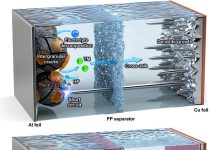
Scientists in Australia have developed a remarkable new paint-like coating that can keep buildings cool and collect fresh water straight from the air—without using any electricity.
The invention, created by researchers at the University of Sydney and start-up Dewpoint Innovations, could help combat both rising heat and global water shortages.
The coating, made from a nanoengineered polymer, reflects up to 97% of sunlight and naturally radiates heat away from the surface it covers.
This keeps the material up to 6°C cooler than the surrounding air, even in direct sunlight.
The temperature difference causes water vapor in the air to condense into droplets on the surface—much like how steam forms on a bathroom mirror. The result is a surface that cools itself while collecting drinkable water from the atmosphere.
“This technology not only advances the science of cool roof coatings but also opens the door to sustainable, low-cost, decentralized sources of fresh water,” said Professor Chiara Neto from the University of Sydney’s Nano Institute and School of Chemistry, who led the research.
“It’s a big step toward climate-resilient water solutions.”
During a six-month outdoor trial on the roof of the Sydney Nanoscience Hub, the coating was able to collect dew for roughly one-third of the year.
Under the right conditions, it can harvest about 390 milliliters of water per square meter daily—enough for a 12-square-meter roof to provide the daily drinking needs of one person.
The study, published in Advanced Functional Materials, shows that the paint can both cool surfaces and produce clean water without relying on any external energy source.
Unlike traditional white paints, which often use titanium dioxide pigments to reflect sunlight, this new coating achieves its high reflectivity through a porous internal structure made of a polymer called PVDF-HFP.
“By removing UV-absorbing pigments, we overcome the traditional limits of solar reflectivity while also avoiding glare,” explained Dr. Ming Chiu, lead author of the study and Chief Technology Officer at Dewpoint Innovations.
“The result is a more durable, visually comfortable coating suitable for real-world use.”
The coating proved stable even under Australia’s intense sun, showing no signs of degradation after months of exposure.
Beyond buildings, the technology could be applied in agriculture, animal farming, or even hydrogen production—where water is a critical ingredient. It could also help reduce urban heat islands and the demand for air conditioning.
The next step is commercial development. Dewpoint Innovations is creating a water-based paint that can be applied with standard rollers or sprayers.
“Imagine rooftops that stay cooler while making their own fresh water,” said Professor Neto.
“That’s the promise of this technology—a simple, energy-free way to make our cities and communities more sustainable.”



